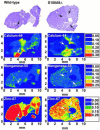Nutritional immunity beyond iron: a role for manganese and zinc
- PMID: 20015678
- PMCID: PMC2847644
- DOI: 10.1016/j.cbpa.2009.11.008
Nutritional immunity beyond iron: a role for manganese and zinc
Abstract
Vertebrates sequester iron from invading pathogens, and conversely, pathogens express a variety of factors to steal iron from the host. Recent work has demonstrated that in addition to iron, vertebrates sequester zinc and manganese both intracellularly and extracellularly to protect against infection. Intracellularly, vertebrates utilize the ZIP/ZnT families of transporters to manipulate zinc levels, as well as Nramp1 to manipulate manganese levels. Extracellularly, the S100 protein calprotectin sequesters manganese and potentially zinc to inhibit microbial growth. To circumvent these defenses, bacteria possess high affinity transporters to import specific nutrient metals. Limiting the availability of zinc and manganese as a mechanism to defend against infection expands the spectrum of nutritional immunity and further establishes metal sequestration as a key defense against microbial invaders.
Copyright 2009 Elsevier Ltd. All rights reserved.
Figures


References
-
- Andreini C, Bertini I, Cavallaro G, Holliday GL, Thornton JM. Metal ions in biological catalysis: from enzyme databases to general principles. J Biol Inorg Chem. 2008;13:1205–1218. - PubMed
-
- Waldron KJ, Rutherford JC, Ford D, Robinson NJ. Metalloproteins and metal sensing. Nature. 2009;460:823–830. - PubMed
-
- Waldron KJ, Robinson NJ. How do bacterial cells ensure that metalloproteins get the correct metal? Nat Rev Microbiol. 2009;7:25–35. - PubMed
-
- Wintergerst ES, Maggini S, Hornig DH. Contribution of selected vitamins and trace elements to immune function. Ann Nutr Metab. 2007;51:301–323. - PubMed
-
- Weinberg ED. Iron availability and infection. Biochim Biophys Acta. 2009;1790:600–605. - PubMed
Publication types
MeSH terms
Substances
Grants and funding
LinkOut - more resources
Full Text Sources
Other Literature Sources
Medical

